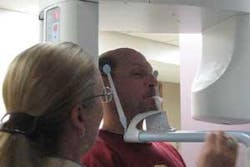Why panoramic? A message for the general dentist
For more on this topic, go to www.dentaleconomics.com and search using the following key words: panoramic X-rays, intraoral X-rays, digital panoramic.
When my older, film-based panoramic "died," I knew that I wanted to replace it to continue these services for my patients. Since I made the switch to digital for my intraoral radiographs, it seemed logical to invest in a digital panoramic system. There are three distinct advantages of digital over film — better diagnostics, time savings, and decreased radiographic overhead.
Diagnostics: Quite honestly, if anything, the image quality on a digital panoramic is as good as or better than a film-based panoramic. Add the software's diagnostic tools, and there's really no comparison. Plus, as soon as we tell patients that the radiation is considerably reduced, they are always pleased.
Time savings: Initially, the greatest impact was on time savings. Digital is fast. Dropping from 15 minutes to take and process a film panoramic to under three minutes for its digital equivalent meant that the patient wasn't kept waiting, my team was on to other tasks, I could read the panoramic immediately, and we could better keep on schedule, even if taking the panoramic was unexpected. Taking the X-ray and seeing it immediately delights my team. It saves "wear and tear" on them! Going back and forth, processing, cleaning the processor, and mixing and ordering chemicals are now in the past. Digital made everything much easier for them. I had the same experience with our intraoral digital system, especially for procedures like root canals where there are three to four X-rays in a single appointment. Since digital is so quick, you can just snap an image and keep on working.
Cost savings: There is an initial investment involved with a digital panoramic. In my case, it was very easy to justify. I knew that I wanted panoramics. To go with a digital panoramic seemed logical because of the reasons I've already mentioned. I knew that I would not be buying panoramic film, chemicals, and processor maintenance supplies, so there was a savings in consumables. Even better, at the end of year one, I took a look at my production figures and supplies savings. We took 951 panoramics during this time. And my panoramic system paid for itself the first year. Now I am still not spending money on film, etc., and my panoramic is still running strong, giving a positive monetary return.
Choosing the right system: We looked at three different panoramics. Price, image quality, and ease-of-use were all part of our criteria. The panoramic we settled on (Orthoralix 8500) did everything the others did but at a better price. And the image quality was as good as or better than the others. It was easy to incorporate. The technicians took about two hours to install the system and that included a few minutes to show the staff the basics. Since it was easy to operate, my team started taking images that afternoon on the fly, even before their "formal training."
I would urge my fellow general dentists to consider adding panoramics to their practices. It is a way to increase valuable patient services and, secondarily, profits.
Dr. Roscoe Scott graduated from the UMKC School of Dentistry in 1974, then served in the Air Force at Randolph AFB, Texas, before starting his private practice in Overland Park, Kan., in 1977. Dr. Scott has embraced technology in his practice, implementing computerization, electronic charting, digital X-rays, and the latest generation of CAD/CAM and laser systems.

